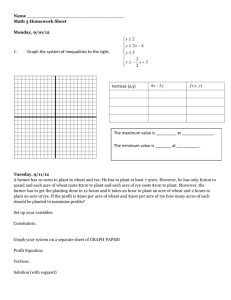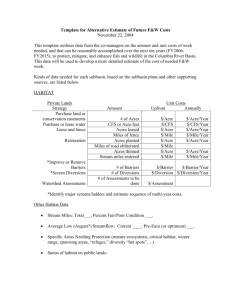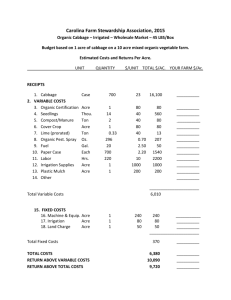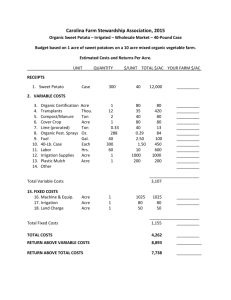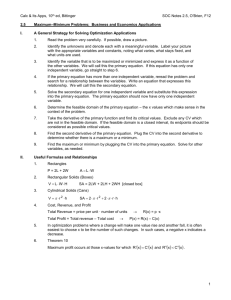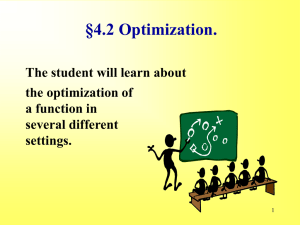Presentation - John Slankas
advertisement
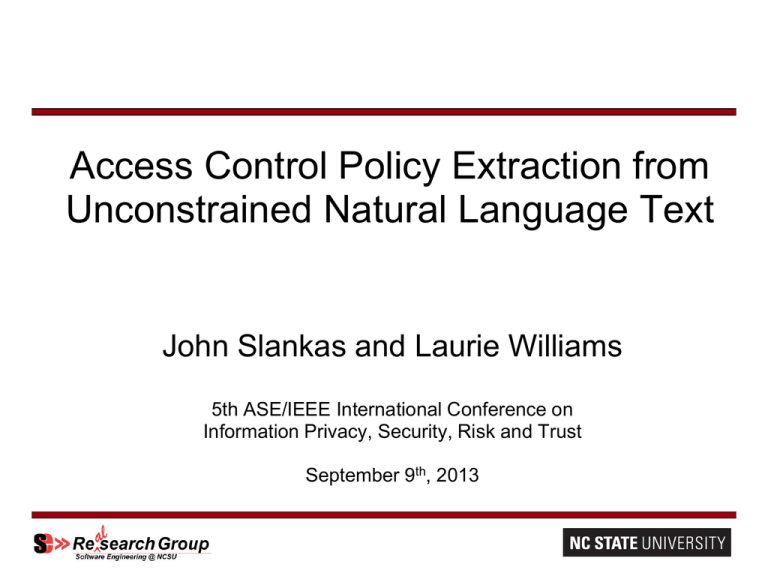
Access Control Policy Extraction from Unconstrained Natural Language Text John Slankas and Laurie Williams 5th ASE/IEEE International Conference on Information Privacy, Security, Risk and Trust September 9th, 2013 Motivation Research Prior Solution Method Evaluation Future Relevant Documentation for Healthcare Systems • • • • • HIPAA HITECH ACT Meaningful Use Stage 1 Criteria Meaningful Use Stage 2 Criteria Certified EHR (45 CFR Part 170) • • • • • • • • HIPAA Omnibus NIST Testing Guidelines DEA Electronic Prescriptions for Controlled Substances (EPCS) Industry Guidelines: CCHIT, EHRA, HL7 State-specific requirements • • • • ASTM HL7 NIST FIPS PUB 140-2 North Carolina General Statute § 130A-480 – Emergency Departments Organizational policies and procedures Project requirements, use cases, design, test scripts, … Payment Card Industry: Data Security Standard 2 Motivation Research Solution Method Research Goal Research Questions Evaluation Future Help developers improve security by extracting the access control policies implicitly and explicitly defined in natural language project artifacts. 3 Motivation Research Solution Method Research Goal Research Questions Evaluation Future 1. How effectively can we identify access control policies in natural language text in terms of precision and recall? 2. What common patterns exist in sentences expressing access control policies? 3. What is an appropriate set of seeded graphs to effectively bootstrap the process to extract the access control elements? 4 Motivation Approach Research Solution Method Representation Evaluation Future Process Access Control Relation Extraction (ACRE) Natural language documents contain explicit and implicit access control statements: • A nurse can order a lab procedure for a patient. • The doctor may add or remove patients from the monitoring list. • Only doctors can write prescriptions. 6 Motivation Approach Research Prior Solution Representation Method Evaluation Process Access Control Relation Extraction (ACRE) 7 Future Motivation Approach Research Prior Representation Solution Method Process ACRE: Sentence Representation “The nurse can order a lab procedure for a patient.” 8 Evaluation Future Motivation Approach Research Prior Representation Solution Method Evaluation Process ACRE: Policy Representation 𝐴( 𝑠 , 𝑎 , 𝑟 , 𝑛 , 𝑙 , 𝑐 , 𝐻, 𝑝) 𝑠 vertices composing the subject 𝑎 vertices composing the action 𝑟 vertices composing the resource 𝑛 vertex representing negativity 𝑙 vertex representing limitation to a specific role 𝑐 vertices providing context to the access control policy 𝐻 subgraph required to connect all previous vertices 𝑝 set of permission associated with the current policy 𝐴( 𝑛𝑢𝑟𝑠𝑒 , 𝑜𝑟𝑑𝑒𝑟 , 𝑙𝑎𝑏 𝑝𝑟𝑜𝑐𝑒𝑑𝑢𝑟𝑒 , , , 𝑉: 𝑛𝑢𝑟𝑠𝑒, 𝑜𝑟𝑑𝑒𝑟, 𝑙𝑎𝑏 𝑝𝑟𝑜𝑐𝑒𝑑𝑢𝑟𝑒; 𝐸: (𝑜𝑟𝑑𝑒𝑟, 𝑛𝑢𝑟𝑠𝑒, 𝑛𝑠𝑢𝑏𝑗); (𝑜𝑟𝑑𝑒𝑟, 𝑙𝑎𝑏 𝑝𝑟𝑜𝑐𝑒𝑑𝑢𝑟𝑒, 𝑑𝑜𝑏𝑗) ), 𝑐𝑟𝑒𝑎𝑡𝑒) 𝐴( 𝑛𝑢𝑟𝑠𝑒 , 𝑜𝑟𝑑𝑒𝑟 , 𝑝𝑎𝑡𝑖𝑒𝑛𝑡 , , , (𝑉: 𝑛𝑢𝑟𝑠𝑒, 𝑜𝑟𝑑𝑒𝑟, 𝑝𝑎𝑡𝑖𝑒𝑛𝑡; 𝐸: (𝑜𝑟𝑑𝑒𝑟, 𝑛𝑢𝑟𝑠𝑒, 𝑛𝑠𝑢𝑏𝑗); (𝑜𝑟𝑑𝑒𝑟, 𝑝𝑎𝑡𝑖𝑒𝑛𝑡, 𝑝𝑟𝑒𝑝_𝑓𝑜𝑟) ), 𝑟𝑒𝑎𝑑) 9 Future Motivation Approach Research Solution Representation Method Evaluation Future Process ACRE: Step 1 - Parse Text Document Read input from a text file to identify major “types” of lines Titles Lists Sentences / Sentence Fragments document → line line → listID title line | title line | sentence line | λ sentence → normalSentence | listStart (“:” | “-”) listElement listElement → listID sentence listElement | λ listID → listParanID | listDotID | number listParanID → “(” id “)” listParanID | id “)” listParanID | λ listDotID → id “.” listDotID | λ id → letter | romanNumeral | number 10 Motivation Approach Research Solution Method Representation Evaluation Future Process ACRE: Step 2 - Parse Natural Language • Parse text utilizing Stanford Natural Language Parser • Apply transformations to minimize graph. order nsubj nurse NN VB aux can dobj procedure VB MD det det a a DT prep_for DT patient NN nn lab det NN “ A nurse can order a lab procedure for a patient.” 11 a DT Motivation Approach Research Solution Representation Method Evaluation Future Process ACRE: Step 2 - Parse Natural Language • Parse text utilizing Stanford Natural Language Parser • Apply transformations to minimize graph. “ A nurse can order a lab procedure for a patient.” 12 Motivation Approach Research Solution Representation Method Evaluation Process Future Bootstrap ACRE: Step 3 - Classify Does the current sentence contain access control elements? Utilizes a k-NN Classifier as the primary classifier • Ability to find closely matched sentences • Performs well on similar document types If the k-NN Classifier doesn’t find a close match(es), then a majority vote is taken in conjunction with naïve Bayes, and SVM classifiers 13 Motivation Approach Research Solution Representation Method Process ACRE: Step 4 - Extraction 14 Evaluation Future Motivation Approach Research Solution Representation Method Evaluation Future Process ACRE: Step 4 – Extraction / Seed Patterns 1) Determine verb frequency 2) Generate “base” wildcard patterns 3) Determine initial subject and resource lists Iterate 4) From subject and resources, determine graph patterns existing between combinations 5) Apply transformations and wildcards to generate new patterns 6) Examine document for matching patterns • • Extract access control policies Extract newly found subject and resources 15 Motivation Research Context Study Oracle Solution Method Procedure Evaluation Electronic Health Record (EHR) Domain Specifically – iTrust http://agile.csc.ncsu.edu/iTrust Why Healthcare? • # of open and closed-source systems • Government regulations • Industry Standards 16 Future Motivation Research Context Study Oracle Solution Method Procedure 17 Evaluation Future Motivation Research Context Study Oracle Solution Method Procedure Evaluation Future • Evaluate ability to identify access control statements • What machine learning algorithms perform best? • What features affect performance? • Examine identified patterns for commonality • Examine different seed words and patterns 18 Motivation Research Solution Method Evaluation Future RQ1: How effectively can we identify access control policies in natural language text in terms of precision and recall? Stratified Ten-Fold Cross Validation Classifier Precision Recall 𝐅𝟏 Measure Naïve Bayes .743 .940 .830 SMO .845 .830 .837 TF-IDF .588 .995 .739 k-NN (k=1) .851 .830 .840 Combined SL .873 .908 .890 19 Motivation Research Solution Method Evaluation Future RQ2: What common patterns exist in sentences expressing access control policies? From the iTrust Requirements – nsubj S * Specific Action A VB dobj R *NN 20 * NN Motivation Research Solution Method Evaluation Future RQ3: What is an appropriate set of seeded graphs to effectively bootstrap the process to extract the access control elements? nsubj Looking at just a basic pattern: S * Specific Action A VB *NN dobj R Utilizing 10 action verbs as the initial seed to find subjects and resources, we found the existing access control with a precision of .46 and a recall of .536 create, retrieve, update, delete, edit, view, modify, enter, choose, select 21 * NN Motivation Research Prior Solution Method Evaluation So, What’s Next? • Data Modeling • Resolution • Reification • Additional documents, systems, and domains • Use process to inform analysts of ambiguity 23 Future
